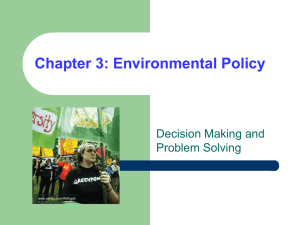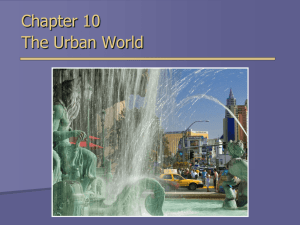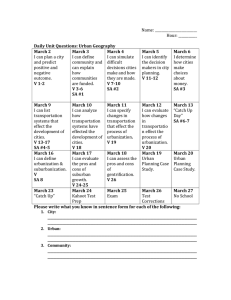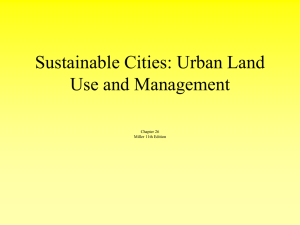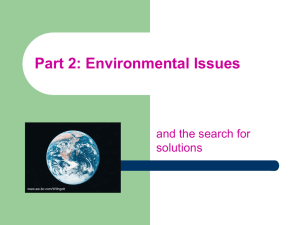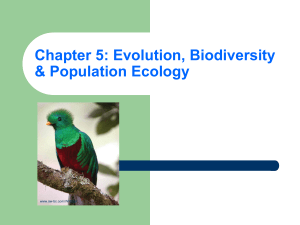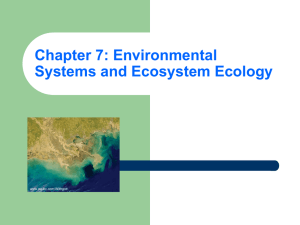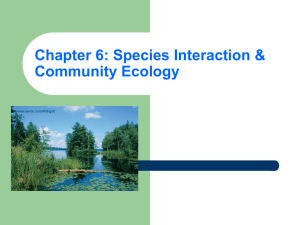Chapter 13: Urbanization
advertisement
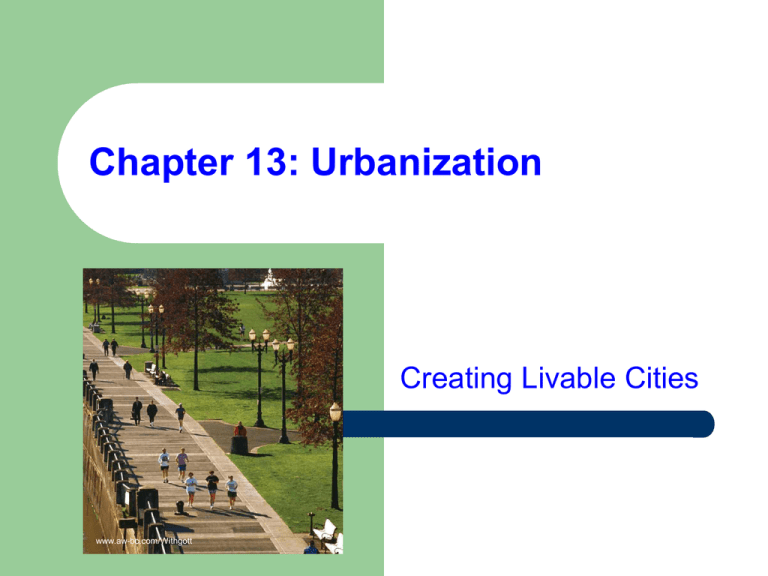
Chapter 13: Urbanization Creating Livable Cities www.aw-bc.com/Withgott Urbanization it is the shift from rural living forming cities and towns. arguably the single greatest change since transitioning from a nomadic hunter-gatherer becoming sedentary people introducing agriculture to our way of life. Industrialization overproduction of agricultural goods lead to the specialization of professions leading to: class structure political hierarchies urban centers positive feedback: better technology= more and better paid jobs= more migration to the cities Population in Developing Countries (2005-2007) www.aw-bc.com/Withgott Geography of Urban Areas Factors: climate topography waterways location, location, location major river (Mississippi, Hudson, Ohio, Colorado) sea coast (Gulf Coast) railroad or highway trading corridor (I-35) To the Suburbs 1950's Pros more space economic opportunities cheaper real estate less crime better schools Cons human impact on the environment longer commute need of car congested traffic pollution lack of green space health land use costs of infrastructure DFW 1990 www.earthvisionllc.net DFW 2000 www.earthvisionllc.net DFW 2009 www.earthvisionllc.net DFW 2014 www.earthvisionllc.net Sprawl "spread of low-density urban or suburban development outward from an urban center." causes for sprawl number of people highways- more people migrate technology (internet)- can work from home preference to space and privacy vs crowdedness per capital land consumption larger homes larger cars larger "stuff" like electric and electronic gadgets Creating Livable Cities city planning parks and playgrounds neighborhood conditions traffic mapping of railroads, bus lines and such regional planning – same principles but in a much larger scale – metroplex zoning Urban Growth Boundaries (UGB) intended to limit sprawl contains future growth within already existing urbanized areas limiting costs of infrastructure it can be adjusted according to needs Pros revitalizes downtown preserves ecosystem: restoration via parks and reserves protects farms and industry already there ensures access to open spaces near city "building up" employment increased Cons costs of housing are increasing density increases size of lots/houses decrease New Urbanism designs neighborhoods with house, school, buisnesses and amenities close together mimic the traditional urban layout that existed before the creation of suburbs very dependant on public transportation www.nctcog.org/TRANS Smart Growth consists of building up, not out – multistory shopping center and housing buildings – Addison Circle mass transit is vital – develops existing communities cheaper, cleaner, efficient predictable, fair and cost-effective spending parks and open spaces community collaboration in city development Urban Sustainability urbanization has positive and negative impacts depends on – – – – use of resources: cities are "resource sinks" production of goods: inefficient material transportation: inefficient waste: more consumption= more waste Pollution some are exported – waste – air pollutants – some water & soil pollutants noise pollution – highways light pollution San Diego L.A. Night view panorama from Palomar observatory www.astro.caltech.edu/palomar Innovation promoting education, technology and scientific research renewable energy pollution reduction local and organic produce recycling programs environmentally friendly technologies tax incentives (cash for clunkers) waste recycling THE END

